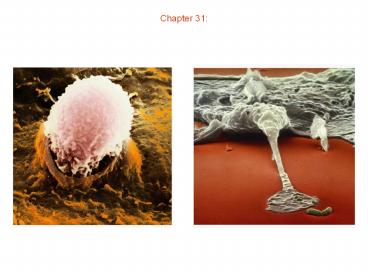Z333 Lecture - PowerPoint PPT Presentation
Title:
Z333 Lecture
Description:
Chapter 31: Defense Against Diseases: The Immune Response – PowerPoint PPT presentation
Number of Views:145
Avg rating:3.0/5.0
Title: Z333 Lecture
1
Chapter 31 Defense Against Diseases The Immune
Response
2
Chapter 31 Immune System
How Does a Body Defend Against Invasion?
3
Chapter 31 Immune System
Barriers (1st Line of Defense)
- Prevent microbes from entering body
- 1) Skin
- Inhospitable environment
- Dry, nutrient-free zone
- Sweat/oil gland secretions (antibiotics)
- Skin sloughed off
- 2) Mucous Membranes (digestive, respiratory,
urogenital tracts) - Secrete mucus (traps microbes)
- Antibacterial enzymes
- Cilia sweep up mucus (swallowed)
4
Chapter 31 Immune System
Non-specific Internal Defenses (2nd Line of
Defense)
- Attack wide variety of microbes that penetrate
barriers - 1) Phagocytic Cells (leukocytes)
- Macrophages (big eaters)
- Ingest microbes via phagocytosis
- Natural Killer Cells
- Attack virus-infected / cancer cells
5
Chapter 31 Immune System
Non-specific Internal Defenses (2nd Line of
Defense)
- Attack wide variety of microbes that penetrate
barriers
2) Inflammation (to set on fire)
- Wounded region ? red, swollen and warm
- Damaged cells 1) release histamine (leaky
vessels) - 2) initiate blood clotting
- 3) attract macrophages (Clean area)
3) Fever (? body temperature)
- Combats large-scale infections (turn up
thermostat - hypothalamus)
- Function 1) increases pacrophage activity
- 2) slows bacterial reproduction
- Increases macrophage activity
6
Chapter 31 Immune System
Specific Immune Response (3nd Line of Defense)
- Complex attack against specific target
(organism / toxin)
- Immune System Cells / molecules that work
together - to combat the microbial invasion
- Key Players (leukocytes lymphocytes)
- B cells Mark / inactivate foreign invaders
in blood - T cells Destroy foreign invaders in cells
- Table 31-1 (Overview of cell types)
7
Chapter 31 Immune System
Fundamental Steps in Immune Response
1) Immune system must recognize invader...
- Antigen Molecule located on cell surface
which triggers - an immune response.
- B cells produce antibodies which recognize
antigens
- Y-shaped
- 4 chains (2 light 2 heavy)
- Variable / constant regions
- Antigen binding site
- High specificity
8
Chapter 31 Immune System
Fundamental Steps of Immune Response
1) Immune system must recognize invader...
- Antigen Molecule located on cell surface
which triggers - an immune response.
- B cells produce antibodies which recognize
antigens
- Antibodies may bind to B cell
(Figure 31.6)
9
Chapter 31 Immune System
Fundamental Steps of Immune Response
1) Immune system must recognize invader...
- Antigen Molecule located on cell surface
which triggers - an immune response.
- B cells produce antibodies which recognize
antigens
- T cells produce T-cell Receptors which
recognize antigens
Why doesnt our immune system destroy our own
cells?
Answer Major Histocompatibility Complex (MHC)
- Unique set of proteins / polysaccharides which
- identify self cells of body
- Act as antigens in other individuals bodies
10
Chapter 31 Immune System
Fundamental Steps in Immune Response
2) Immune system must launch attack...
- A) Humoral Immunity (B cells / circulating
antibodies) - Attacks invaders (bacteria, protists, fungi)
prior to cell entry - (1) B cell antibody receptor binds antigen
- (2) Activated B cell divides rapidly (clonal
selection) - (a) Memory cells (Future immunity)
- (b) Plasma cells ? antibodies (released into
blood)
11
Chapter 31 Immune System
Clonal Selection
(Figure 31.8)
12
Chapter 31 Immune System
B cell ? Plasma cell
(Figure 31.9)
13
Chapter 31 Immune System
Fundamental Steps in Immune Response
2) Immune system must launch attack...
- A) Humoral Immunity (B cells / circulating
antibodies) - Attacks invaders (bacteria, protists, fungi)
prior to cell entry - (1) B cell antibody receptor binds antigen
- (2) Activated B cell divides rapidly (clonal
selection) - (a) Memory cells (Future immunity)
- (b) Plasma cells ? antibodies (released into
blood)
- (3) Antibodies destroy invaders
- Inactivate invader (binding)
- Cause invaders to clump together
- Coat invaders with blood proteins
14
Chapter 31 Immune System
Fundamental Steps in Immune Response
2) Immune system must launch attack...
- B) Cell-mediated Immunity (T cells)
- Attacks invaders (viruses, cancers) after they
enter body cells - (1) Cytotoxic T cells
- Release proteins ? disrupt plasma membrane
- (2) Helper T cells
- Stimulate immune cells (via hormones)
- Destroyed by AIDS virus
- (3) Suppressor T cells
- Activated following infection shut down B / T
cells - (4) Memory T cells
- Protect body against future invasion
15
Chapter 31 Immune System
Fundamental Steps in Immune Response
3) Immune system must remember past victories...
- Memory cells remember specific antigens
- May survive for years
- Respond faster and larger to repeat invasion
16
Chapter 31 Immune System
Medical Care Augments Immune Response
- 1) Antibiotics Slow down microbial
reproduction (not viruses) - Problem Antibiotic resistant strains
- 2) Vaccinations Injection of killed microbes
to confer immunity - Stimulates development of memory cells
17
Chapter 15 Immune System
Malfunctions of Immune System
- 1) Allergies Adverse reaction to harmless
substances - B cells recognize substance as antigen
(histamine release) - Anaphylactic Shock
- 2) Autoimmune Disease Body mistakes own cells
as invaders - Diabetes mellitus (Type I) Destruction of
pancreatic cells - Multiple Sclerosis Destruction of neuron
insulation (myelin) - 3) Immunodeficiency Disease
- Severe Combined Immune Deficiency (SCID)
(Bubble Boy) - Aquired Immune Deficiency Syndrome (AIDS)
- 4) Cancer Unchecked growth of tumor cells
- Cells evade / overwhelm immune system































